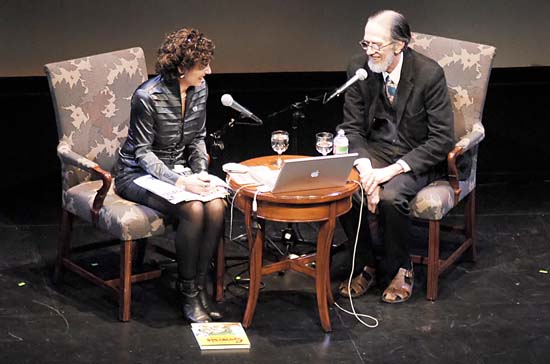In the beginning, there was the word, and for R. Crumb, that word is enclosed in a cartoon thought bubble. Through Feb. 7 at the Hammer Museum, underground comic book artist Crumb’s “The Bible Illuminated: The Book of Genesis” shows his distinctively detail-oriented and bawdy vision of the Bible.
Known for satirizing American pop culture through an acid-soaked lens in the 1960s and ’70s with the creation of controversial characters like Mr. Natural, an aphorism-spouting guru who often provided snide comments on American culture, Crumb switched gears and has spent the last five years refining his vision of Genesis for a book-length publication.
He uses only the words of the King James Bible and, through researching other illustrated bibles, including the first comic bible by M.C. Gaines and children’s bibles, Crumb aimed more for narrative storytelling than satirical subversion.
“(Crumb) really left it for the viewer to sort of make their own interpretations about the drawings,” said Ali Subotnick, the exhibit’s curator. “He left it to the viewer to interpret what the people and the architecture and the facial expressions look like, and he lets the drawings speak for themselves.”
The Hammer exhibit is a world premiere of Crumb’s original illustrations for the pages of his book, “The Book of Genesis Illustrated,” displayed in the order in which they will appear in the published book. While Crumb did not initially intend for the pages to appear in a museum exhibit, seeing the original drawings in person allows for another look into Crumb’s notoriously mysterious vision.
“You notice things that you don’t see in the book, like how much White-Out he used not just for correcting but in the form of highlighting,” Subotnick said. “You just see the artist’s hand and the thickness of the ink or the lightness of the ink. You really get a sense of how long and how much he put into making these drawings and that he actually did make them by hand.”
Within the exhibit, viewers can not only view the original drawings but also Crumb’s original research files with clippings organized by objects that he portrayed in the final book, including women, animals, architecture, costumes and cities.
“He had been trying to get somewhat accurate in those details,” Subotnick said. “He would freeze-frame biblical movies and take pictures of the television screen, so there were a lot of different references that he used. You get a sense of the time he spent just researching.”
Despite Crumb’s meticulous research, his vision ““ albeit his fairly literal and detailed vision ““ inevitably creates controversy as it portrays the Bible and religion as literature and, therefore, could be construed as fictional.
“Institutions should not be held hostage by individuals or groups who subscribe to the fiction that religion itself is nonfictional or, in other words, non-aesthetic,” said Donald Preziosi, a UCLA professor emeritus of art history, in an e-mail correspondence from Germany. Preziosi is currently writing a book on the subject of art and religion, called “Enchanted Credulities: Art, Religion, and Amnesia,” that will include a discussion of Crumb’s “Genesis.”
“This exhibit … perhaps signals to a wider audience that politically and religiously controversial artwork is very well suited to a public institution like the Hammer, which since its founding has sought to engage critically and intellectually with modern and contemporary artistry in all of its manifestations, and has done so very well as a responsible, university-affiliated institution committed to education and the fostering of public dialogue about art, society and culture,” Preziosi said.
The Hammer will continue this dialogue not only with the museum exhibit but also with related events. They screened Terry Zwigoff’s bio-documentary “Crumb” on Nov. 3 in the Billy Wilder Theater.
“It’s the definitive documentary of Crumb,” said Claudia Bestor, the director of public programs and education. “He is an amazingly wonderfully twisted person, and this is his creation story. You meet his family, and it shows his own upbringing.”
On Nov. 10, the Billy Wilder Theater will also host a night of improvisational jazz music in the ragtime style as a soundtrack to 1920s and 1930s cartoons on 35 millimeter film that inspired Crumb’s illustrations.
Bestor finds that the related programs can enhance an understanding of the man behind the drawings.
“The Bible itself is human interpretation. The Bible was written by many different people over a long period of time and was transmitted orally. The words of the Bible are very subjective and very individual, so seeing the film (that inspired Crumb) will certainly enhance where (Crumb’s) vision is coming from,” Bestor said.
On the heels of Crumb’s rare appearance in conversation with “New Yorker” art editor Françoise Mouly, the Hammer’s exhibit continues the dialogue not only about the Bible but also about the nature of comic art itself.
“The distinction between comics and art is a specious one; there is no significant difference inherent to the forms themselves,” Preziosi said. “Any differences are expressions of political and social attitudes.”
Subotnick said he hopes that this showcase of comic art may draw a broader audience to the Hammer Museum. He added that the opening on Oct. 24 drew 350 people.
“In the act of taking on such a heavy book, Crumb realized early on that he didn’t even have to take a satirical approach,” Subotnick said. “It’s almost untouchable.”
